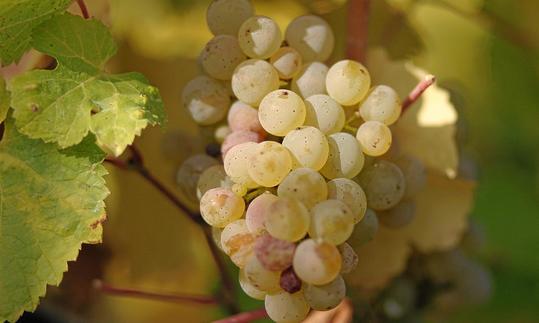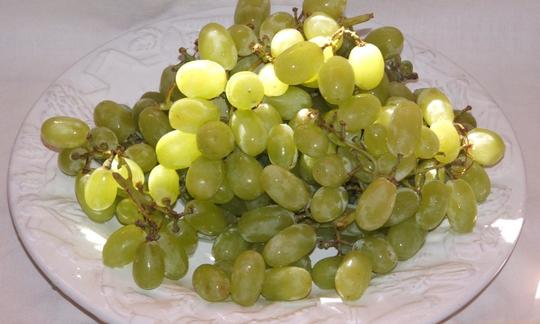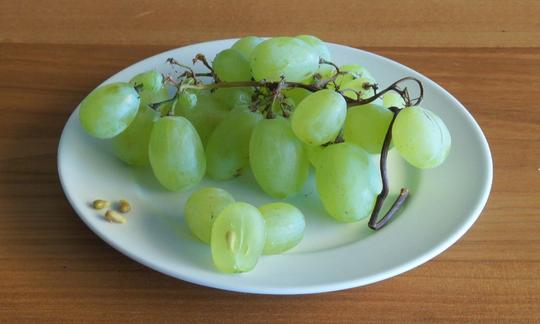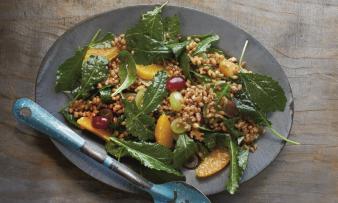Table of contents
Grapes ( Vitis vinifera ) can be eaten raw, dried (to make raisins ) or processed into wine . Grape vines have yellow-green or red berries, the latter being slightly sweeter.
Use in the kitchen
Raw grapes are a very popular fresh fruit due to their sweet and sour taste. Grapes grown for direct consumption are also called table grapes; they have larger berries and a thinner skin than wine grapes (e.g. for making wine). In this text we will deal with European grape varieties (for details see the chapter Further information).
Fresh grapes are a healthy snack when eaten raw and taste great in fruit salad, salads or muesli ( pea muesli ). The seeds are also edible raw. Light and dark grapes differ in their aroma. The flesh of blue, purple and red grapes is sweeter and more aromatic than the light varieties. Yellow to green varieties contain more acid and often have a nutmeg note.
Grapes are a good source of antioxidants in a raw food smoothie. If you press grapes into grape juice, you get a fruity and refreshing drink. Grapes are excellent for making jam, jelly or compote. You can also easily make syrup from them with apples and a little lemon .
They are popular as decoration or topping, also in combination with savory dishes. They go well on a vegan oriental couscous with pomegranate seeds, mint, basil and rocket . If you want to give dishes such as sauerkraut or other vegetables a sweet note, cooked red grapes are a great choice.
Some berries have a white film on their skin. This is not necessarily a residue of pesticides or mold, but rather a scented film that protects the grapes from drying out and is easy to wash off.
So-called wine grapes are fermented and processed into wine, brandy or liqueur (such as port wine ). Brandy is made from the residue left after pressing, also known as pomace. If you leave wine open or add acetic acid bacteria, you get wine vinegar (light white wine vinegar has a lighter taste than red wine vinegar ). In addition to the grape seed oil obtained from the seeds, there is also brown-reddish and gluten-free grape seed flour.
Vegan recipe for salad with grapes
Ingredients (for 2 people): 1head of lettuce (or romaine lettuce, Batavia lettuce ), ½ red pepper, 50 g walnuts, 40 g fresh grapes (organic). For the dressing: 2 tablespoons honey (alternatively agave syrup ), 1 teaspoon mustard, ½ tablespoon rapeseed oil, 1 tablespoon balsamic vinegar or white wine vinegar and 1 tablespoon water .
Preparation: Wash the lettuce, remove the stalk and tear into small pieces. Cut the pepper into strips and chop the walnuts into small pieces. Put all the ingredients in a bowl with the halved organic grapes. Mix the honey, mustard, water and vinegar in a glass. Add the oil, season with a little salt and mix everything in a bowl and serve.
Vegan recipes with grapes can be found under the note: " Recipes that have the most of this ingredient ".
Purchasing - Storage
At major retailers such as Coop, Migros, Denner, Volg, Spar, Aldi, Lidl, Rewe, Billa, Edeka, Hofer and the organic supermarkets Denn's Biomarkt and Alnatura, grapes can be bought all year round, often as organic wine grapes. In the main season from September to November, local fruit is available. From July onwards, they come from Spain, France, Greece, Turkey or the USA. In the winter months, India and South Africa are the main suppliers.
The availability of grapes varies depending on the size of the store, catchment area, etc. Our recorded food prices for the DA-CH countries can be found above under the ingredient image - and by clicking on them you can see their development at different suppliers.
Storage tips
Grape berries are non-climacteric fruits. This means that they do not ripen after harvest. They are therefore best stored at room temperature (4-5 days). If you want to enjoy them for longer, you can do so for up to two weeks by storing them unwashed in a closed container in the refrigerator. The loss of aroma at cooler temperatures must be taken into account. Therefore, the berries should be warmed up to room temperature for around 20 minutes before consumption, this will restore the full-bodied taste of the grapes. Dried grapes ( raisins, sultanas or currants) allow for longer storage.
Ingredients - Nutritional values - Calories
Raw grapes have a calorie content of about 69 kcal/100g and consist of about 80% water and 18% carbohydrates (including 15 g sugar). Protein and fat are hardly present. 1
What vitamins do grapes contain? Grapes contain 15 µg of vitamin K per 100g, which is 19% of the daily requirement. Artichokes and fresh carrot juice contain a similar amount. In comparison , chard contains a particularly high amount of this vitamin, at 830 µg per 100g. 100 g of table grapes also provide 0.09 mg of vitamin B6 and 3.2 mg of vitamin C. 1
With 191 mg of potassium, 100 g of table grapes cover 10% of the daily requirement. Among fruits, peaches and mulberries have similar values. Raw avocados have significantly more, at 485 mg/100g. 1
In addition to copper, the micronutrients manganese, iron, zinc, fluorine and selenium are also present. The main acids in grapes are malic and tartaric acid. The pulp mainly contains the monosaccharides glucose and fructose. 2,27
Compared to muscadine grapes, classic grapes contain significantly more sugar and lessfiber .
The complete ingredients of grapes, the coverage of the daily requirement and comparison values with other ingredients can be found in our nutrient tables. In the article Nutrients explained you will get a detailed insight into the topic.
Health effects
The health effects of grapes are due to the secondary plant substances they contain.
Secondary plant substances
Our article on secondary plant substances provides an overview of the classification of substance groups, their occurrence in foods and possible effects on humans. Grapes contain the following secondary plant substances:
Isoprenoids: Terpenoids: Triterpenoids (oleanolic acid); Carotenoids : carotenes (β-carotene), xanthophylls (violaxanthin, antheraxanthin, zeaxanthin, lutein) 32
Polyphenols: Flavonoids: anthocyanins (cyanidin-3-O-glucoside, delphinidin-3-O-glucoside), flavanols (catechins, epicatechin), flavonol (quercetin, rutin, myricetin, fisetin), flavone (morin); stilbenes (resveratrol); tannins (proanthocyanidins); phenolic acids: hydroxycinnamic acids (p-coumaric acid, caffeic acid, ferulic acid); hydroxybenzoic acid (vanillic acid, gentisic acid, gallic acid) 4,5,31
Are grapes healthy? The grape is a fruit with many bioactive components. The grapes, the stem, the seeds and the fruit peel contain flavonoids, polyphenols, anthocyanidins and stilbenes, among others. White fruits contain a higher content of flavanols than red ones. Anthocyanidins (pigments), on the other hand, are mainly found in red grapes. 4 Anthocyanidins have a high antioxidant capacity and can neutralize free radicals in the body. Flavonoids serve as protection for the plant itself against predators and UV radiation. Extracts from seeds show anticarcinogenic and antibacterial effects on the human organism. 3 In an in vivo study, 20 subjects drank 7 ml of red grape juice per kg of body weight per day for 14 days. The scientists report that due to the high flavonoid content and their antioxidant properties, there is less platelet aggregation in whole blood, which has a cardioprotective effect. 5
The polyphenol resveratrol has antioxidant and anti-cancer effects. A synthetic variant has been approved as a dietary supplement since 2016. The anti-inflammatory substance is mainly found in the skin of red grapes. In 2021, scientists investigated the physiological effects of resveratrol in red grapes and Japanese knotweed in a cell experiment. It is known that in the case of a bacterial infection, cells release inflammatory markers such as interleukin-6 as a signaling substance of immune reactions. When resveratrol was used, a 70% decrease in interleukin-6 was observed. It can therefore be assumed that resveratrol significantly reduces the release of signaling substances that are involved in inflammatory processes and has an anti-inflammatory effect. 6
Grapes contain oligomeric proanthocyanidins (OPCs). These are health-promoting phenolic compounds, such as the procyanidin polymers found in the seeds or the prodelphinidins (also known as tannins) found in the skin. 4,7 These secondary plant substances have an antioxidant, anticarcinogenic, antibacterial and antiviral effect and are therefore a popular dietary supplement in the form of preparations (extracts from grape seeds). 8 A study shows that proanthocyanidins inhibit the breakdown of vitamin E in red blood cells exposed to oxidative stress from UV-B radiation and prevent the dissolution of red blood cells (hemolysis). In in vitro tests, proanthocyanidin shows a better antioxidant effect than vitamins C and E. 9
Dangers - Intolerances - Side effects
Grapes are considered to be well tolerated and side effects rarely occur. However, in large quantities they can have a laxative effect. The fiber content and sugar alcohols (xylitol or sorbitol) can lead to diarrhea or flatulence. People with digestive problems should choose seedless grapes, which are easier to digest.
Allergic reactions due to the high fructose content can occur in people with fructose intolerance and cause gastrointestinal discomfort, itching and swelling. 14
Conventional grapes are often contaminated with pesticide residues. These can cause skin rashes or other allergic reactions. Even if you wash these grapes before eating them, you can only remove some of them because many pesticides have penetrated deep into the skin. 15
The high use of copper (also commonly used as a fungicide in organic farming) and its impact on the environment and human health are always the subject of discussion. Copper has been used as an inorganic agent for around 150 years, e.g. to combat downy mildew ( Pernospora viticola ), and it gets into the soil and groundwater. An excess of copper in the soil has a toxic effect on aquatic organisms. 10 Since 2006, the amount of copper used in viticulture has been limited to 8 kg/ha per year in order to reduce copper contamination in the soil. The EU organic regulation allows 6 kg of pure copper/ha/year, but many organic associations specify a maximum of 3 kg/year. 11 Copper is absorbed not only through the fruit, but also through drinking water. The recommended copper intake of 1-1.5 mg per day should be observed (DA-CH reference values), 12 in order to avoid an excess of copper and the associated side effects such as nausea and vomiting. 13
Use as a recognized medicinal plant
Grape leaves are mainly used as a medicinal plant in the form of tea to treat symptoms of diarrhea, inflammation of the oral mucous membranes, bruising, vomiting, skin rashes or varicose veins. Red leaves (Vitis viniferae folium rubrum) are used for venous disorders, heavy legs or circulatory disorders. A study with a commercially available preparation tested the effect of the main flavonoids quercetin-3-O-beta-glucuronide and isoquercitrin (quercetin-3-O-beta-glycoside) in red grape leaves on patients with chronic venous insufficiency (CVI). After taking the vein capsules, pain and tension decreased. The edema on the patients' legs also decreased significantly. 16
Folk medicine - natural healing
The Egyptians used grapes or raisins as a natural laxative for digestive problems. Today we know that the combination of cellulose, acid and fructose has a laxative effect. In ancient times they were used as a diuretic (to drain the body). Ripe grapes also helped with vascular diseases, constipation, obesity and liver problems.
Another fine drink is the so-called vine water (vine secretion, vine tear, bleeding juice). It comes out at the cuts on the vine before new shoots appear and is used to disinfect the plant itself. It hardens over time to close the vine's "wound" to bacteria. In folk medicine it is used to disinfect eye and ear diseases. In 1993 a chemical institute confirmed the disinfecting and antibacterial effect of the substances cineole, alpha-terpineole and thymol. 17
Ecological footprint - animal welfare
The ecological footprint of grapes depends on the country of origin, the cultivation method and the packaging. The production of 1 kg of seasonal grapes from Germany or Italy produces 0.3 kg CO 2 eq/kg. 29 In European supermarkets, table grapes are a very popular fruit alongside apples and oranges - even in the winter months. Between January and May, however, grapes mainly come to Europe from other continents, from countries such as India and South Africa. A PET tray containing 500 g of grapes from these countries reaches the consumer's home with the help of a refrigerated container ship, truck and car: this has twice the CO 2 footprint (0.66 kg CO 2 eq/kg) compared to seasonal, regional grapes. The greatest potential for saving emissions for grapes from overseas lies in replacing PET trays with plastic bags, 18 but ideally grapes are bought seasonally and as regionally as possible and sold loose.
The amount of water required to produce 1 kg of grapes is 608 litres. 30 In countries that have to contend with water shortages due to climatic conditions and rely on artificial irrigation to irrigate the grapes, this has a particularly strong impact on the ecological footprint (e.g. Italy). 19 In terms of biodiversity loss due to water use, table grapes from the USA score 588 gPDF-eq*a (global potentially disappeared fraction of species equivalent / year) per kilo; asparagus from Mexico (1768 gPDF-eq*a per kilo) and bananas from Peru (720 gPDF-eq*a per kilo) fare even worse. Table grapes from Italy are much more environmentally friendly in terms of water consumption, at 42 gPDF-eq*a per kilo. 19
For detailed explanations of various sustainability indicators (such as ecological footprint, CO2 footprint, water footprint), see our article: What does the ecological footprint mean?
Animal welfare - species protection
Plant protection products are repeatedly criticized in both viticulture and table grape cultivation. One problem is that there is no legal limit for multiple residues. Only individual residues are determined. In tests from 2020, 13 different active ingredients were detected on a table grape sample from Italy (tests were carried out on 34 samples, 26 of which were green grapes and 8 were red, for pesticide residues). There were also residues on Italian organic samples that are considered "drift" due to the low levels (the insecticide detected is not approved in the DA-CH countries). In general, pesticides were detected in 94% of the samples from Italy, Brazil, Peru, Greece and Spain. 20 pesticides have been proven to be harmful to soil, surface water, groundwater, terrestrial habitats, plants, insects, birds and mammals to varying degrees. 21 Therefore, when buying table grapes, it is important to look for fruit from organic farming in order to avoid additional burdens on the environment.
Worldwide occurrence - cultivation
The grapevine, Vitis vinifera, is a grape variety with genetic centers in the Mediterranean and western Asia. As the oldest domesticated crop with more than 10,000 different varieties, it has been used in vineyards for wine production for thousands of years.22 Archaeological finds in Georgia and the Nile Valley indicate that wine production took place from 6000 BC.23 It was further spread by the Phoenicians, Greeks and Romans in ancient times. The Greeks and Romans in particular used the vine not only for viticulture but also as a source of food. They began to breed new grape varieties and viticulture spread to Europe as well. In the 15th and 16th centuries the grapevine came to America and eventually to Latin America, to the regions of Chile and Argentina. The main table grape growing areas in Europe today are Italy, Spain, Greece and Turkey. In the winter months, imports are made from South Africa or India. 24
Wildly found
Wild grapes can only be found with a little luck and when it comes to a vine that was once cultivated and has become wild. Since care and cultivation measures are lacking, the berries on wild vines are usually much smaller.
Danger of confusion
Virginia creeper ( Parthenocissus quinquefolia ) or the three-lobed Virginia creeper ( Parthenocissus tricuspidata ) look similar to the grapevine ( Vitis vinifera ), 25 because they all belong to the grapevine family. 25 Their significantly smaller fruits are black-blue, the leaf stalks turn reddish in autumn and the leaves are trifoliate and smaller than those of Vitits vinifera . Eating large amounts of these berries can cause symptoms of poisoning due to the high oxalic acid content, which is why they are classified as slightly poisonous. Symptoms include vomiting, gastrointestinal discomfort and excessive urination. 26
Cultivation - Harvest
The grape is a summer green, self-fertile, woody and liana-like plant. It can climb up to 35 m high with the help of its two- or multi-armed tendrils. The vines bloom from May to June. Fruit development then begins. Its fruits are berries that are spherical to oval in shape and can be green, yellow, pink, purple or black. The ripening period of the grapes begins in August and they reach a size of 0.6 to 2.2 cm. 27 The grapes are most enjoyable when fully ripe and are therefore best harvested. Seedless (parthenocarpic) fruits are very popular with table grapes; this is possible due to a lack of fertilization (virgin fruit). Seedless grapes can also be created artificially using hormones such as auxins. 24
As a climbing plant, grapes grow ideally on a house wall, on walls or on a trellis. However, as they have deep roots, they are not suitable for planting in pots. Pre-cultivated vines (container plants) are available commercially. These can also develop well in pots. Grapes thrive at quite high temperatures (an average of 8.5 °C, 11-16 °C is ideal) and in locations protected from the wind. Regular watering promotes good fruit development, but waterlogging should be avoided. From the second year onwards, cut the shoots back (after the winter frosts) into the desired shape (training form).
A grafted vine is planted so deep that the grafting point is at least 5 cm above the ground. Otherwise, roots will form on the scion or the rootstock will be rejected. In viticulture, grafting is when a resistant variety (resistant to phylloxera) is used as the rootstock and rootstock. The fruit-bearing variety (scoop) is grafted onto the rootstock using special cutting techniques. 28
Pay attention to the health of the leaves. If the leaves are yellowing or have fungal or viral infections, thinning them out is the first step. This also applies to the fruit: small and rotten berries should be thinned out. If everything goes well, the first grape harvest will take place in the second year.
In the vineyard, the grapes are harvested in late summer or early autumn, depending on the variety and climate. Physiological ripeness is reached when the fruit skin is thin, the seeds are brown and the flesh tastes juicy and sweet. Ripe fruits can also be easily separated from the stems. Another characteristic is that the fruit stems begin to become woody. The best way to determine the optimal harvest time is by tasting them. When picking, care should be taken to handle the fruit as carefully as possible and to damage it as little as possible to avoid rapid spoilage.
Further information
The grapevine belongs to the genus Vitis, which is divided into two subgenera. Firstly, the Vitis subg. Muscadinia with 3 species and the Vitis subg. Euvitis with 60 species. These are divided into three groups according to their geographical occurrence: the Asian, American and European groups. The European Vitits vinifera is the most important for viticulture and table cultivation. The hybrid varieties of the American Vitis labrusca are particularly popular for making juice. American varieties are interesting for breeding and cross-breeding because they are often resistant to phylloxera or tolerant to certain types of fungi. 24
Alternative names
The fruits of the grapevine are colloquially known as wine berries, grapes or grapes. As fresh fruit, the berry is called table grape. In English, the grape is called grape. When we talk about sultana, currant or zibebe, we mean raisins.
Bibliography - 30 Sources
| 1. | US-Amerikanische Nährwertdatenbank USDA. 2019. |
| 2. | Baumgartner D, Pulver D, Ruffner HP. Säure in Traubenmost und Wein. Schweizer Zeitschrift für Obst- und Weinbau. 2023;14(04):11. |
| 3. | Nassiri-Asl M, Hosseinzadeh H. Review of the pharmacological effects of Vitis vinifera (Grape) and its bioactive compounds. Phytother Res. September 2009;23(9):1197–1204. |
| 4. | Xia EQ, Deng GF, Guo YJ, Li HB. Biological activities of polyphenols from grapes. IJMS. 4. February 2010;11(2):622–646. |
| 5. | Freedman JE, Parker C et al. Select flavonoids and whole juice from purple grapes inhibit platelet function and enhance nitric oxide release. Circulation. 12. June 2001;103(23):2792–2798. |
| 6. | Tiroch J, Sterneder S et al Bitter sensing tas2r50 mediates the trans-resveratrol-induced anti-inflammatory effect on interleukin 6 release in hgf-1 cells in culture. J Agric Food Chem. 17. November 2021;69(45):13339–13349. |
| 7. | Hernández-Jiménez A, Gómez-Plaza E et al. Grape Skin and Seed Proanthocyanidins from Monastrell × Syrah Grapes. Journal of Agricultural and Food Chemistry. 2009;57(22):10798–10803. |
| 8. | Gupta M, Dey S et al. Grape seed extract: having a potential health benefits. J Food Sci Technol. April 2020;57(4):1205–1215. |
| 9. | Facino R, Carini M et al. Sparing Effect of Procyanidins from Vitis vinifera on Vitamin E: In vitro Studies. Planta Med. May 1998;64(04):343–347. |
| 10. | Kühne S, Friedrich B. Pflanzenschutz im Ökologischen Landbau - Probleme und Lösungsansätze - Siebtes Fachgespräch am 6. Juni 2002 in BerlinDahlem, "Alternativen zur Anwendung von Kupfer als Pflanzenschutzmittel". Berichte aus der Biologischen Bundesanstalt. 2003;118. |
| 11. | Öko-Institut e.V. Kupfer im Biolandbau. Hintergrund, Herausforderungen und Handlungsempfehlungen. 2014. |
| 12. | BfR Bundestinstitut für Risikobewertung. Höchstmengenvorschläge für Kupfer in Lebensmitteln inklusive Nahrungsergänzungsmitteln. 2021. |
| 13. | Elmadfa I, Leitzmann C. Ernährung des Menschen. 5., vollständig überarbeitete und erweiterte Auflage. Stuttgart: Verlag Eugen Ulmer; 2015. |
| 14. | Koletzko S, Koletzko B. Wenn Zucker krank machen - Maldigestion und metabolische Unverträglichkeiten. Aktuelle Ernährungsmedizin. 2006;31:68–75. |
| 15. | KTipp. Test: Bis zu 15 verschiedene Pestizide in frischen Trauben. 2018/15. |
| 16. | Monsieur R, Van Snick G. Efficacy of the red vine leaf extract AS 195 in Chronic Venous Insufficiency. Praxis Schweizerische Rundschau für Medizin. 2006;95(6):187-190. |
| 17. | Jirovetz L, Buchbauer G, Remberg G, Nikiforov A. Inhaltsanalyse des Rebstocksekretes (Rebtränen) mittels GC-FTIR-MS. VITIS - Journal of Grapevine Research. 1994;33(2):97. |
| 18. | Golombek S, Blanke M. CO2-Fussabdruck indischer Tafeltrauben auf dem Weg zum deutschen Konsumenten – Analyse und Ansätze zu seiner Verminderung. Erwerbs-Obstbau. 2020;62(3):109–114. |
| 19. | Zhiyenbek A, Bretta C. Ökobilanzierung Früchte- und Gemüseproduktion: eine Entscheidungsunterstützung für ökologisches Einkaufen. ETH Zürich. 2016: 31. |
| 20. | LAVES. Niedersächsisches Landesamt für Verbraucherschutz und Lebensmittelsicherheit. Pflanzenschutzmittelrückstände in Tafeltrauben. Ergebnisse des Jahres 2020. |
| 21. | Scnat. Akademie für Naturwissenschaften. Pestizide: Auswirkungen auf Umwelt, Biodiversität und Ökosystemleistungen. Swiss Academies Factsheets. 2021;16(2). |
| 24. | Bauer K. Weinbau. 13. aktualisierte Auflage. München: AV Buch. 2019. |
| 25. | BfR Bundesinstitut für Risikobewertung. Bekanntmachung einer Liste besonders giftiger Gartenpflanzen und einheimischer Pflanzen in der freien Natur. 2021. |
| 26. | Hermanns-Clausen M, Koch I et al. Akzidentelle Vergiftungen mit Gartenpflanzen und Pflanzen in der freien Natur: Daten aus zwei deutschen Giftinformationszentren. Bundesgesundheitsblatt - Gesundheitsforschung - Gesundheitsschutz. Januar 2019;62(1):73–83. |
| 27. | Rolf B. Online Lehrbuch: Weinbau und Reben in der Flora Mitteleuropas. Uni Hohenheim. 2000. |
| 28. | Landesbetrieb Landwirtschaft Hessen. Rasim S, Trapp M. Die Tafeltraubenkultur. 2010. |
| 29. | Reinhardt G, Gärtner S, Wagner T. Ökologische Fussabdrücke von Lebensmitteln und Gerichten in Deutschland. Institut für Energie- und Umweltforschung Heidelberg. 2020. |
| 30. | Mekonnen MM, Hoekstra AY. The green, blue and grey water footprint of crops and derived crop products. Hydrol. Earth Syst. Sci. 2011; 15: 1577-1600. |
| 31. | Rapp A, Ziegle A. Bestimmung der Phenolcarbonsäuren (Hydroxybenzoesäuren und Hydroxyzimtsäuren) in Rebblättern, Weintrauben und Wein mittels Mikro-Polyamid-Dünnschichtchromatographie. Vitis. 1973;12:226-236. |
| 32. | Teixeira A, Noronha H et al. Biosynthesis of Chlorophyll and Other Isoprenoids in the Plastid of Red Grape Berry Skins. J Agric Food Chem. 2023;71(4):1873-1885. |













Comments